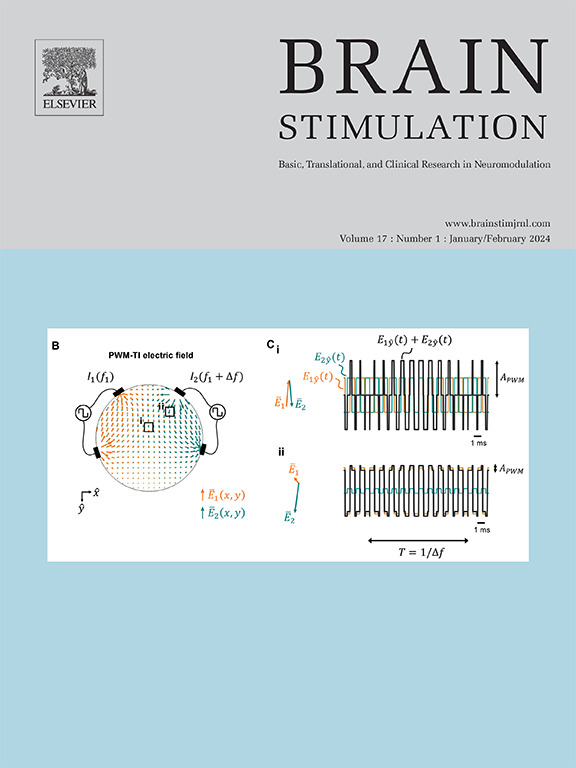Induced zero-phase synchronization as a potential neural code for optimized visuomotor integration
IF 8.4
1区 医学
Q1 CLINICAL NEUROLOGY
引用次数: 0
Abstract
Background
Goal-directed behavior requires the integration of information from the outside world and internal (somatosensory) sources about our own actions. Expectations (or ‘internal models’) are generated from prior knowledge and constantly updated based on sensory feedback. This optimized information integration (‘predictive coding') results in a global behavioral advantage of anticipated action in the presence of uncertainty. Our goal was to probe the effect of phase entrainment of the sensorimotor mu-rhythm on visuomotor integration.
Methods
Participants received transcranial alternating current stimulation over bilateral motor cortices (M1) while performing a visually-guided force adjustment task during functional magnetic resonance imaging.
Results
Inter-hemispheric zero-phase entrainment resulted in effector-specific modulation of performance precision and effector-generic minimization of force signal complexity paralleled by BOLD activation changes in bilateral caudate and increased functional connectivity between the right M1 and contralateral putamen, inferior parietal, and medial temporal regions. While effector-specific changes in performance precision were associated with contralateral caudate and hippocampal activation decreases, only the global reduction in force signal complexity was associated with increased functional M1 connectivity with bilateral striatal regions.
Conclusion
We propose that zero-phase synchronization represents a neural mode of optimized information integration related to internal model updating within the recursive perception-action continuum associated with predictive coding.
诱导零相位同步作为优化视觉运动整合的潜在神经编码。
背景:目标导向的行为需要整合来自外部世界和内部(体感)的关于我们自己行为的信息。预期(或“内部模型”)是从先前的知识中产生的,并根据感官反馈不断更新。这种优化的信息整合(“预测编码”)导致在不确定性存在时预期行动的整体行为优势。我们的目的是探讨感觉运动韵律的相带性对视觉运动整合的影响。方法:在功能磁共振成像期间,参与者在执行视觉引导的力调节任务时,在双侧运动皮质(M1)上接受经颅交流电刺激。结果:大脑半球间零相位夹带导致了动作精度的效应特异性调节和力信号复杂性的效应性最小化,与此同时,双侧尾状核的BOLD激活变化和右侧M1与对侧壳核、下顶叶和内侧颞区之间的功能连接增加。虽然对侧尾状体和海马的激活减少与效应特异性的动作精度变化有关,但只有力信号复杂性的整体减少与双侧纹状体区域M1功能连接的增加有关。结论:零相位同步代表了一种与预测编码相关的递归感知-行动连续体内部模型更新相关的优化信息整合的神经模式。
本文章由计算机程序翻译,如有差异,请以英文原文为准。
求助全文
约1分钟内获得全文
求助全文
来源期刊

Brain Stimulation
医学-临床神经学
CiteScore
13.10
自引率
9.10%
发文量
256
审稿时长
72 days
期刊介绍:
Brain Stimulation publishes on the entire field of brain stimulation, including noninvasive and invasive techniques and technologies that alter brain function through the use of electrical, magnetic, radiowave, or focally targeted pharmacologic stimulation.
Brain Stimulation aims to be the premier journal for publication of original research in the field of neuromodulation. The journal includes: a) Original articles; b) Short Communications; c) Invited and original reviews; d) Technology and methodological perspectives (reviews of new devices, description of new methods, etc.); and e) Letters to the Editor. Special issues of the journal will be considered based on scientific merit.
 求助内容:
求助内容: 应助结果提醒方式:
应助结果提醒方式:


